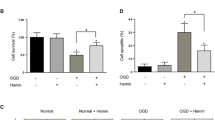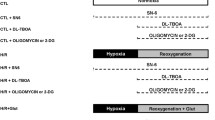Abstract
Oxidative stress-induced neuronal cell death requires opening of the mitochondrial permeability transition pore. P53 mitochondrial translocation and association with Cyclophilin D (Cyp-D) is required for the pore opening. Here we tested this signaling axis in oxygen glucose deprivation (OGD)/re-oxygenation-induced in vitro neuronal death. Using mitochondrion immunoprecipitation, we found that p53 translocated to mitochondrion and associated with Cyp-D in SH-SY5Y cells exposed to (OGD)/re-oxygenation. Disruption of this complex by Cyp-D inhibitor Cyclosporine A (CsA), or by Cyp-D or p53 deficiency, significantly inhibited OGD/re-oxygenation-induced apoptosis-independent cell death. Conversely, over-expression of Cyp-D in SH-SY5Y cells caused spontaneous cell death, and these cells were more vulnerable to OGD/re-oxygenation. Finally, CsA or Cyp-D RNAi suppressed OGD/re-oxygenation-induced neuronal cell death in primary cultures. Together, our study suggests that OGD/re-oxygenation-induced in vitro cell death involves a mitochondrial Cyp-D/p53 signaling axis.




Similar content being viewed by others
Abbreviations
- OGD:
-
Oxygen glucose deprivation
- Cyp-D:
-
Cyclophilin D
- CsA:
-
Cyclosporine A
- H2O2 :
-
Hydrogen peroxide
- LDH:
-
Lactate dehydrogenase
- mPTP:
-
Mitochondrial permeability transition pore
- ROS:
-
Reactive oxygen species
- NAC:
-
n-Acetyl cysteine
- GFP:
-
Green fluorescence protein
- MEFs:
-
Mouse embryonic fibroblasts
- ANT:
-
Adenine nucleotide translocase
- VDAC:
-
Voltage-dependent anion transporter
References
Blokhina O, Virolainen E, Fagerstedt KV (2003) Antioxidants, oxidative damage and oxygen deprivation stress: a review. Ann Bot 91:179–194. doi:10.1093/aob/mcf118
Almeida A, Delgado-Esteban M, Bolanos JP, Medina JM (2002) Oxygen and glucose deprivation induces mitochondrial dysfunction and oxidative stress in neurones but not in astrocytes in primary culture. J Neurochem 81:207–217. doi:10.1046/j.1471-4159.2002.00827.x
Tavakoli-Far B, Rahbar-Roshandel N, Rahimi-Moghaddam P, Mahmoudian M (2009) Neuroprotective effects of mebudipine and dibudipine on cerebral oxygen-glucose deprivation/reperfusion injury. Eur J Pharmacol 610:12–17. doi:10.1016/j.ejphar.2009.03.017
Park JW, Jang YH, Kim JM, Lee H, Park WK, Lim MB, Chu YK, Lo EH, Lee SR (2009) Green tea polyphenol (−)-epigallocatechin gallate reduces neuronal cell damage and up-regulation of MMP-9 activity in hippocampal CA1 and CA2 areas following transient global cerebral ischemia. J Neurosci Res 87:567–575. doi:10.1002/jnr.21847
Yasui H, Asanuma T, Watanabe Y, Waki K, Inanami O, Kuwabara M (2007) Oral administration of antioxidant biofactor (AOBtrade mark) ameliorates ischemia/reperfusion- induced neuronal death in the gerbil. BioFactors 29:113–121
Martinez Sanchez G, Candelario-Jalil E, Giuliani A, Leon OS, Sam S, Delgado R, Nunez Selles AJ (2001) Mangifera indica L. extract (QF808) reduces ischaemia-induced neuronal loss and oxidative damage in the gerbil brain. Free Radic Res 35:465–473
Baines CP, Kaiser RA, Purcell NH, Blair NS, Osinska H, Hambleton MA, Brunskill EW, Sayen MR, Gottlieb RA, Dorn GW, Robbins J, Molkentin JD (2005) Loss of cyclophilin D reveals a critical role for mitochondrial permeability transition in cell death. Nature 434:658–662. doi:10.1038/nature03434
Halestrap AP, Gillespie JP, O’Toole A, Doran E (2000) Mitochondria and cell death: a pore way to die? Symp Soc Exp Biol 52:65–80
Halestrap AP (2006) Calcium, mitochondria and reperfusion injury: a pore way to die. Biochem Soc Trans 34:232–237. doi:10.1042/BST20060232
Halestrap A (2005) Biochemistry: a pore way to die. Nature 434:578–579. doi:10.1038/434578a
Nakagawa T, Shimizu S, Watanabe T, Yamaguchi O, Otsu K, Yamagata H, Inohara H, Kubo T, Tsujimoto Y (2005) Cyclophilin D-dependent mitochondrial permeability transition regulates some necrotic but not apoptotic cell death. Nature 434:652–658. doi:10.1038/nature03317
Schinzel AC, Takeuchi O, Huang Z, Fisher JK, Zhou Z, Rubens J, Hetz C, Danial NN, Moskowitz MA, Korsmeyer SJ (2005) Cyclophilin D is a component of mitochondrial permeability transition and mediates neuronal cell death after focal cerebral ischemia. Proc Natl Acad Sci USA 102:12005–12010. doi:10.1073/pnas.0505294102
Basso E, Fante L, Fowlkes J, Petronilli V, Forte MA, Bernardi P (2005) Properties of the permeability transition pore in mitochondria devoid of Cyclophilin D. J Biol Chem 280:18558–18561. doi:10.1074/jbc.C500089200
Halestrap AP, McStay GP, Clarke SJ (2002) The permeability transition pore complex: another view. Biochimie 84:153–166. doi:S0300908402013755
Vaseva AV, Marchenko ND, Ji K, Tsirka SE, Holzmann S, Moll UM (2012) p53 opens the mitochondrial permeability transition pore to trigger necrosis. Cell 149:1536–1548. doi:10.1016/j.cell.2012.05.014
Baumann K (2012) Cell death: multitasking p53 promotes necrosis. Nat Rev Mol Cell Biol 13:480–481. doi:10.1038/nrm3401
Ji C, Yang B, Yang Z, Tu Y, Yang YL, He L, Bi ZG (2012) Ultra-violet B (UVB)-induced skin cell death occurs through a cyclophilin D intrinsic signaling pathway. Biochem Biophys Res Commun 425:825–829. doi:10.1016/j.bbrc.2012.07.160
Lopez E, Ferrer I (2000) Staurosporine- and H-7-induced cell death in SH-SY5Y neuroblastoma cells is associated with caspase-2 and caspase-3 activation, but not with activation of the FAS/FAS-L-caspase-8 signaling pathway. Brain Res Mol Brain Res 85:61–67. doi:S0169328X00002357
Karch J, Molkentin JD (2012) Is p53 the Long-Sought Molecular Trigger for Cyclophilin D-Regulated Mitochondrial Permeability Transition Pore Formation and Necrosis? Circ Res 111:1258–1260. doi:10.1161/CIRCRESAHA.112.280990
Acknowledgments
This research was supported in part by grants from the National Natural Science Foundation of China. Funding recourses have no role in study design; in the collection, analysis and interpretation of data; in the writing of the report; and in the decision to submit the article for publication.
Conflict of Interest
There authors have no conflict of interests.
Author information
Authors and Affiliations
Corresponding author
Additional information
Li-Ping Zhao and Chao Ji two authors contribute equally.
Rights and permissions
About this article
Cite this article
Zhao, LP., Ji, C., Lu, PH. et al. Oxygen Glucose Deprivation (OGD)/Re-Oxygenation-Induced In Vitro Neuronal Cell Death Involves Mitochondrial Cyclophilin-D/P53 Signaling Axis. Neurochem Res 38, 705–713 (2013). https://doi.org/10.1007/s11064-013-0968-5
Received:
Revised:
Accepted:
Published:
Issue Date:
DOI: https://doi.org/10.1007/s11064-013-0968-5




